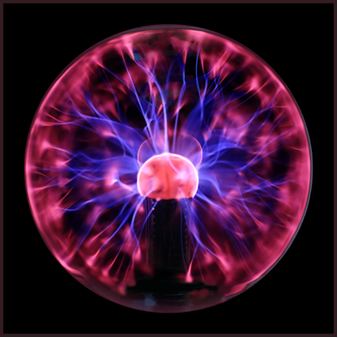GIn our daily life, it is very common to see substances in the so-called three states (aggregation or physical) of matter, which are: solid, liquid and gas. However, there is a fourth physical state of matter, that is not so common here on Earth, but oddly enough, it is believed that 99% of everything that exists in the universe is in this fourth state, called the plasma.
In order to form the plasma, it is necessary that the matter in the gaseous state is heated to very high temperatures, as it happens, by example, in the core of stars, such as our Sun, where there are certain regions of their surface that are in approximately 84,000°C.

The plasma is at a temperature of approximately 84,000 °C in certain regions of the sun's surface
This high temperature causes the gas molecules to break up, forming free atoms, which, in turn, lose and gain electrons, generating ions. So we can say that plasma is formed by a hot and dense set of free atoms, electrons and ions, in a distribution almost neutral (number of positive and negative particles is practically equal), which have behavior collective.
Some might say that plasma is not actually a fourth state of matter, but since it is an ionized gas, it is in a gaseous state. It is quite true that, like gases, plasma has no defined shape and volume, assuming the shape and volume of the container that contains it. However, plasma has other properties that really distinguish it from other states of aggregation.
For example, since it has charged particles, plasma is a electrical conductor, responding strongly to electromagnetic fields and forming structures such as filaments, rays and double layers; this is not the case with gases.
It's interesting, too, that the plasma not only reacts, but also generates magnetic fields. This is because an electric current forms inside it, thanks to its free electrons, and, according to Ampere's Law, an electromagnetic field is formed. Electrons also move in a circular fashion according to the magnetic field of the plasma, and with the temperature very high, this movement can cause the emission of electromagnetic waves. An example of these extremely intense magnetic fields that we can observe is the formation of convection columns of heat from the Sun, which give rise to sunspots, solar winds, etc.
Here on Earth, plasma only occurs in special situations. The first time it was described was in the creation of the Crookes ampoule, developed by the English physicist Willian Crookes (1832-1919) in the 1850s, also called cathode ray tube. It is a glass tube, filled with gases at low pressure, and which has electrodes, that is, a negative pole (cathode) and a positive pole (anode), connected to a generator.
Do not stop now... There's more after the advertising ;)
When a high voltage is applied to the gas contained in the ampoule, the formation of rays coming from the cathode is observed, which were called cathode rays and produce a greenish fluorescence when they hit the glass wall of the ampoule. Thus, plasma is generated in Crookes' ampoule.

Crookes ampoule image 1
The English physicist J. J. Thomson (1856-1940) later used this light bulb to discover the electron. See more about this in the text Thomson's experiment with electrical discharges. In 1928, Irving Langmuir he called these cathode rays "plasma" because of the ability of the plasma of electrical discharges to mold itself into the tubes where they are generated.

Irving Langmuir was the first to use the term "plasma"
Another example of the occurrence of plasma here on Earth occurs in the nuclear fusion reactors, the best known of which is the Tokamak, from Princeton, United States, which works at a temperature of 100 million degrees Celsius, which is achieved through controlled fission reactions. The plasma is trapped inside, where there is controlled thermonuclear fusion of light isotopes of hydrogen and helium, generating a colossal amount of energy. These same fusion reactions take place on the Sun.

Image of the interior of a Tokamak type reactor, through which the plasma passes2
In everyday life, we see an example of plasma in the fluorescent lamps and in processes of sterilization. plasma lamps, like the one shown below, can be purchased as souvenir.

At Austral and Boreal auroras they are the result of the excitation of atoms and molecules in the atmosphere, when bombarded by charged particles expelled from the Sun and deflected by the geomagnetic field, being, therefore, natural plasmas.

* Image credits:
[1] Author: D-Kuru/Wikimedia Commons, License: CC-BY-SA-3.0-AT
[2] Author: Mike Garrett/Wikimedia Commons
By Jennifer Fogaça
Graduated in Chemistry



